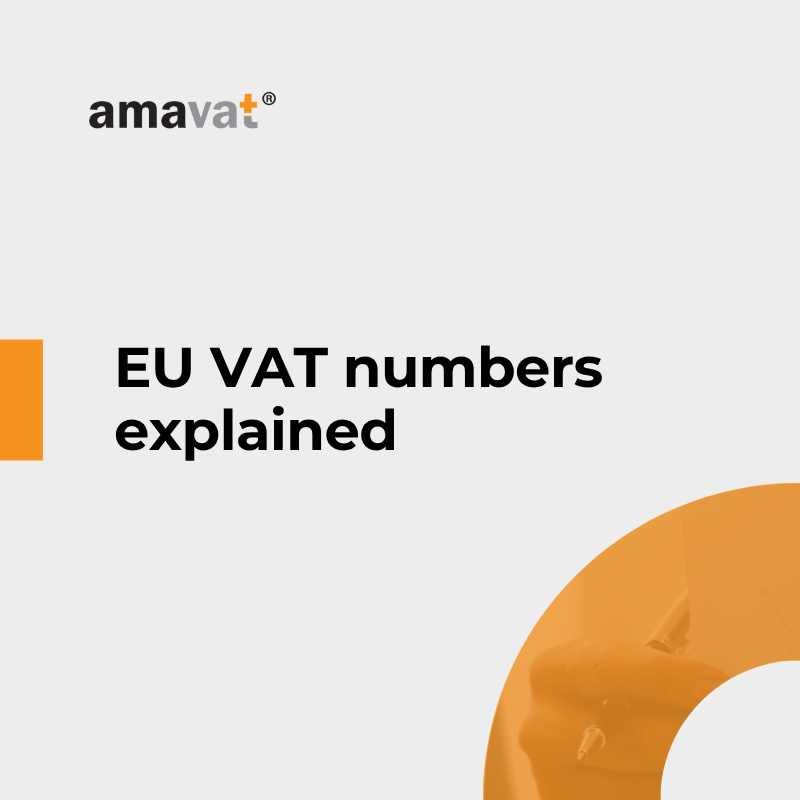EU VAT Numbers Explained: Types, Formats, and Uses

Spis treści
To keep things clear, let’s start with the basics: VAT stands for Value-Added Tax — a form of consumption tax that’s applied to goods and services at each stage of the supply chain. If you run a business in Europe, you’re likely already familiar with it — or you soon will be.
To keep everything running smoothly and transparently, each VAT-registered business in the EU is assigned a unique VAT number. You can think of it as a cross-border tax identification number. It tells tax authorities — and your business partners — that your company is officially registered for VAT in your country.
So why is this number so important? For one, you can’t issue a compliant invoice to an EU customer without it. It’s also essential for intra-EU trade, applying VAT exemptions, and correctly handling reverse charge transactions. And if you’re not using the correct number in the correct way? That can lead to administrative problems — and potentially financial penalties.
In this blog post, we’ll walk you through everything you need to know about EU VAT numbers, including:
- What an EU VAT number actually is,
- The different types and formats across member states,
- Who needs one,
- How to register,
- And what it’s used for in day-to-day business operations.
Let’s dive in and make sense of how EU VAT numbers work — step by step.
What is an EU VAT Number?
Let’s start with the essentials: an EU VAT number (also known as a VAT ID or VAT registration number) is a unique identifier assigned to a business or organization that is registered for Value-Added Tax (VAT) in a European Union country. You can think of it as your business’s official tax ID for VAT purposes within the EU — and it’s required if you’re buying, selling, or providing services across EU borders.
Once your business is registered for VAT, the national tax authority will issue this number. And just like every EU country has its own language and regulations, each country also has its own VAT number format — differing in length, structure, and character types.
That said, there is one rule that applies across all EU member states: every VAT number begins with a two-letter country code, such as DE for Germany or FR for France. This prefix is followed by a sequence of digits, and in some cases, letters — depending on the country’s specific formatting rules. For example:
- A German VAT number might look like: DE123456789
- A Spanish one could be: ESX1234567X
- And for the Netherlands: NL123456789B01
Even though VAT numbers vary in format, they all serve the same core purpose: to confirm that a business is properly registered for VAT in a given country. That’s why it’s so important to recognize and understand valid formats — especially when working across borders or validating VAT numbers for invoicing and compliance.
💡 Tip: If you need to verify whether a VAT number is valid and properly registered in another EU member state, you can use the VIES (VAT Information Exchange System) — the official online tool provided by the European Commission. It’s a reliable and widely used resource for cross-border VAT validation.
Types of EU VAT Numbers
While all EU VAT numbers serve the same basic purpose — identifying businesses registered for VAT — their formats can vary quite a bit from one country to another. Each EU member state has developed its own structure, with differences in character types, number length, and specific formatting rules.
Some VAT numbers are made up entirely of digits, while others include letters at specific positions. Most of them are between 8 and 12 characters long, depending on the country. Since there is no single standard across the EU, it’s important to recognize what a valid format looks like in each jurisdiction — especially when working with international clients or suppliers.
Here are some examples from well-known EU member states:
- Austria (AT) – Starts with the letter ‘U’, followed by 8 digits.
Example: ATU12345678 - Belgium (BE) – 10 digits in total. If only 9 digits are available, a zero is added at the beginning.
Example: BE0123456789 - Germany (DE) – Simple format: 9 digits, no letters.
Example: DE123456789 - Ireland (IE) – Can include letters at the end or mixed within the number.
Example: IE1234567WA - Spain (ES) – Often includes a letter at the beginning, the end, or both.
Example: ESX1234567X - Netherlands (NL) – Always 12 characters long. The 10th character is a ‘B’, followed by a 2-digit code.
Example: NL123456789B01
Each of these formats is designed to meet national tax system requirements and often includes built-in checks to help prevent errors.
What about non-EU countries?
Even though we’re focusing on EU VAT numbers, there are a few non-EU countries whose VAT numbers often show up in EU-related trade. These include:
- United Kingdom (GB) – Still relevant for EU trade, even after Brexit.
Example: GB123456789 - Norway (NO) – Part of the European Economic Area (EEA), Norway uses a VAT system that aligns with many EU practices.
Example: NO123456789MVA - Switzerland (CHE) – Has its own VAT format but is often involved in cross-border transactions with EU countries.
Example: CHE-123.456.789 MWST
Who Needs a VAT Number?
You might be wondering: Do I really need a VAT number? In many cases, the answer is yes — especially if your business is involved in selling goods or services within the European Union, or trading across its borders.
Let’s take a closer look at the main situations where registering for VAT becomes necessary.
EU-based businesses selling goods or services
If your business is established in an EU country and you’re selling goods or providing services that are subject to VAT, then you’re generally required to register for VAT and obtain a VAT number.
This applies to both physical products and digital services. The VAT number allows you to:
✔ issue compliant invoices,
✔ collect VAT from customers,
✔ and reclaim VAT on your business expenses.
It’s a key part of staying compliant with local tax regulations.
Businesses acquiring goods from other EU countries
If your company is purchasing goods from suppliers based in other EU member states, you’re engaging in what’s called an intra-EU acquisition.
In this case, you’ll need a VAT number in order to:
✔ receive goods without being charged foreign VAT upfront,
✔ report the acquisition in your VAT return,
✔ and account for the VAT in your own country under the reverse charge mechanism.
Without a valid VAT number, the supplier may be obligated to charge VAT in their country — which could increase your costs unnecessarily.
Businesses involved in reverse charge transactions
The reverse charge mechanism shifts the responsibility for accounting for VAT from the seller to the buyer. This is common in cross-border business-to-business (B2B) transactions within the EU — particularly for services.
If you’re receiving services from another EU-based company, you may be required to self-account for VAT, and a valid VAT number is essential to ensure correct reporting and compliance.
Non-EU businesses operating in the EU
Even if your company is based outside the EU, you may still need a VAT number if you’re conducting taxable activities within the EU. Common examples include:
- selling goods to EU customers,
- storing inventory in EU warehouses (such as through Amazon FBA),
- or offering digital services to EU consumers.
In these cases, non-EU businesses are often required to register for VAT in one or more EU countries. Fortunately, schemes like the One-Stop Shop (OSS) and Import One-Stop Shop (IOSS) make VAT registration and reporting more manageable for foreign sellers.
How to Obtain an EU VAT Number
Once you’ve determined that your business needs a VAT number, the next step is registration. The good news is that the process is generally straightforward, although the specific requirements can vary depending on the country.
Here’s how it works.
Registration through local tax authorities
If your business is based in the EU, you’ll need to register for VAT in the country where your business is established. Each EU member state has its own tax authority, registration portal, and procedures, but the core steps are similar: you submit an application, provide the necessary business details, and wait for confirmation.
Typically, you’ll be asked to provide:
- Your business name and legal structure
- Company registration number
- Business address
- A description of your business activities
- Estimated sales or turnover
In some cases, supporting documents may be required — such as articles of incorporation, contracts, or proof that your business is operational.
Online registration options
In most EU countries, the VAT registration process can be completed online, which simplifies things considerably. There’s usually no need to send physical documents or schedule appointments with tax offices.
That said, the ease of the process can vary. Some countries offer intuitive, multilingual online platforms, while others may be less accessible. If you’re unsure how to proceed — especially due to language barriers or unclear instructions — many businesses choose to use VAT registration services for support.
Processing times
The time it takes to obtain a VAT number depends on the country. In some cases, such as Estonia or Ireland, it may take only a few days. In others, including Italy or Spain, the process can take several weeks, particularly if additional verification steps are required or if there is a backlog.
As a general guideline, it’s wise to allow between 1 and 8 weeks for registration to be completed.
Also, note that some countries may require proof that your business is already conducting taxable activities — for example, a draft invoice or contract — before issuing the VAT number.
Non-EU businesses
If your company is based outside the EU but sells to EU-based customers — whether through an online shop, platforms like Amazon, or via digital services — you may still be required to register for VAT within the EU.
To make this process more efficient, the EU offers two simplified registration schemes:
➜ OSS (One-Stop Shop) – For non-EU businesses selling goods or services within the EU.
➜ IOSS (Import One-Stop Shop) – For businesses shipping low-value goods (under €150) directly to EU consumers.
These schemes allow you to register in one EU member state, but report and remit VAT across all participating countries — avoiding the need for multiple local registrations.
💡 Tip: If you’re not sure where to register or how to begin, it’s a good idea to check the website of the relevant national tax authority or speak with a VAT specialist. Getting the process right from the beginning can help you avoid delays, incorrect filings, and potential penalties later on.
Uses of an EU VAT Number
So, you’ve got your VAT number — great! But what do you actually do with it? As it turns out, a VAT number isn’t just a formality or something to stick on your invoice. It plays an essential role in your day-to-day business operations, especially if you’re trading across EU borders.
Here’s where and how you’ll use it.
On invoices and legal documents
Let’s start with the basics. If your business issues VAT invoices, your VAT number must appear on them. That’s a legal requirement — whether you’re selling within your own country or to customers in other EU member states.
It’s also good practice to check your suppliers’ VAT numbers when receiving invoices. If their number is missing or incorrect, it could complicate things when you try to deduct input VAT or justify the expense to your local tax office.
For VAT returns and reclaiming input VAT
Your VAT number is also essential when filing your VAT returns. It links your business to the transactions you report — both the VAT you’ve charged your customers and the VAT you’ve paid on your own business expenses.
Without a valid VAT number, you can’t reclaim input VAT, and that means higher costs for your business. Having this number (and using it correctly) ensures you stay compliant and don’t miss out on valuable VAT refunds.
For intra-EU trade – VIES validation
If you’re selling goods or services to businesses in other EU countries, things get a little more technical. In many cases, you can apply a 0% VAT rate (also known as intra-community supply) — but only if both you and your customer are VAT-registered.
This is where your VAT number — and your customer’s — come into play.
You can use the VIES system (VAT Information Exchange System) to check whether a VAT number is valid in another EU country. It’s quick, easy, and highly recommended before issuing invoices without VAT. A simple check can save you from major headaches later.
To ensure correct VAT treatment (and avoid penalties)
Using the wrong VAT number, forgetting to include one, or using a number that’s no longer valid can lead to some serious problems — from delayed payments to tax audits or even fines.
If you operate in more than one EU country (for example, via warehouses, subsidiaries, or online sales), make sure to use the correct VAT number for each jurisdiction. Mixing them up can create confusion in your VAT filings and make it harder to defend your tax position if reviewed by authorities.
VAT numbers may seem like just another string of letters and digits, but as we’ve seen, they play a significant role in how businesses operate across the European Union.
Here’s a quick summary of the key points:
- An EU VAT number is a unique identifier that confirms your business is registered for VAT.
- Each country has its own format — with differences in length, structure, and use of letters or digits — so it’s important to be familiar with them.
- A VAT number is required if your business is selling, purchasing, or receiving services across EU borders, particularly in cases involving reverse charge or intra-community trade.
- You’ll use it on invoices, VAT returns, and VIES checks, among other official documents.
- Even non-EU businesses may be required to register for VAT when trading with the EU.
Most importantly, using the correct VAT number — and applying it properly — helps ensure compliance, prevents costly mistakes, and keeps your international operations running smoothly.






